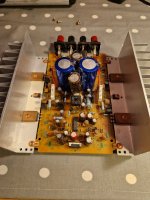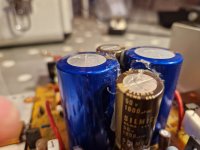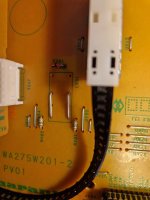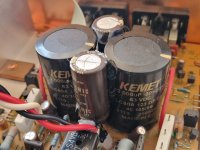Looking for some advice recapping my Marantz 6010 OSE KI amplifier
The caps (C801 and C802) look like they're starting to bulge ever so slightly (no sound quality issues that I have noticed)
The cap part number doesn't bring anything up sarching in google - 12000μF 56V S56V12000UPM20B (I think they're Elna)
In the KI version there are caps in parrallel with these - 1000uf 50v but these look ok.
Any advice appreciated.
The caps (C801 and C802) look like they're starting to bulge ever so slightly (no sound quality issues that I have noticed)
The cap part number doesn't bring anything up sarching in google - 12000μF 56V S56V12000UPM20B (I think they're Elna)
In the KI version there are caps in parrallel with these - 1000uf 50v but these look ok.
Any advice appreciated.
Visual inspection of caps is a non-informative test unless they have blown open and squirted the fluid out.
Cap part # change every two weeks. They mean something only if you have the datasheet from the manufacturer as of the day the cap was produced.
12000 uf 56 v is adequate spec. UPM is a series number of one reasonably long life nichicon line, but the score marks on the top would identify them more purely. There are low ESR caps, but those are useful only for front ends & rails of switcher supplies IMHO.
I re-e-cap when the amp has a problem. Sounds polite on classical music which is supposed to have volume peaks sometimes, I do a max power test. Put in earplugs, turn up on speakers rated more power than the amp. If don't have such speakers, use 8 ohm or 4 ohm log resistors rated higher wattage than the amp.
If starts sounding like a siren or crunch guitar, back off volume a little. that is what clipping sounds like. Then measure AC voltage on speaker or resistor with an analog voltmeter ($30) or an RMS rated DVM ($160) or a scope (multiply peak to peak by 0.7).
Wattage not equal to the amplifier rating, you have a problem.
Or you can take the caps out and measure ESR with a $120 meter. I view this as a destructive test (sometimes). No damage to the amp occurs if you leave the case on.
Other signs of dried up little caps, too much or too little bass, or treble. Volume low on one channel versus the other.
I'm re-eecapping a QSC amp this week because the fan is running full hurricane while producing 2 watts of music. Huge dust balls on the heat sinks & production date of 25 years ago indicates to me there is no point in putting the case back on without making some cap changes. Will do some voltage measuring of the NTC thermistor sensors and the thermistor sense transistor when I get the heat sinks off to look at them. The fan drive transistor passes the double diode test.
Cap part # change every two weeks. They mean something only if you have the datasheet from the manufacturer as of the day the cap was produced.
12000 uf 56 v is adequate spec. UPM is a series number of one reasonably long life nichicon line, but the score marks on the top would identify them more purely. There are low ESR caps, but those are useful only for front ends & rails of switcher supplies IMHO.
I re-e-cap when the amp has a problem. Sounds polite on classical music which is supposed to have volume peaks sometimes, I do a max power test. Put in earplugs, turn up on speakers rated more power than the amp. If don't have such speakers, use 8 ohm or 4 ohm log resistors rated higher wattage than the amp.
If starts sounding like a siren or crunch guitar, back off volume a little. that is what clipping sounds like. Then measure AC voltage on speaker or resistor with an analog voltmeter ($30) or an RMS rated DVM ($160) or a scope (multiply peak to peak by 0.7).
Wattage not equal to the amplifier rating, you have a problem.
Or you can take the caps out and measure ESR with a $120 meter. I view this as a destructive test (sometimes). No damage to the amp occurs if you leave the case on.
Other signs of dried up little caps, too much or too little bass, or treble. Volume low on one channel versus the other.
I'm re-eecapping a QSC amp this week because the fan is running full hurricane while producing 2 watts of music. Huge dust balls on the heat sinks & production date of 25 years ago indicates to me there is no point in putting the case back on without making some cap changes. Will do some voltage measuring of the NTC thermistor sensors and the thermistor sense transistor when I get the heat sinks off to look at them. The fan drive transistor passes the double diode test.
Attachments
Thanks for your advice
They are Elna
I'm looking for advice as to what to replace them with as I'd rather replace them before they fail as I don't want to risk any damage to my speakers.
They are Elna
I'm looking for advice as to what to replace them with as I'd rather replace them before they fail as I don't want to risk any damage to my speakers.
I found unrated service life caps from the TV parts store lasted on average 4-5 years in my ST70 amp. I've found electrolytic caps rated >3000 hours service life have not required repeated replacement. Now that the debit card allows individuals to buy from distributors like farnell & RS, we amateurs are no longer required to trade at the TV parts store. I found farnell & digikey put the hours service life in the selector table, although recently farnell has no longer allowed me even to screen out the wrong size caps. I'm sorry, I'm not wading through 310000 caps to find the right one. Be sure when selecting a replacement, the voltage is same or higher, the height & diameter are not too much. If these are screw terminal caps, I've found changing to snap in caps to be economic. This requires making a transition board of Nema CE laminate or similar, to control the wires with strain relief that I solder to the cap terminals. This also requires gluing down the cap to the chassis, if the steel clamps don't fit the new ones.I'm looking for advice as to what to replace them with
If you buy a PA amp such as Peavey, Crown, or QSC, you will most likely have an amp with protection against DC on speaker. The relay will have been tested to break the arc in actual DC events, unlike those ebay protection toys that include AC rated relays. Also most of the PA models have protection such as DDT to prevent excessive clipping such as crunch guitar from burning your tweeters.
Bottom line, I suggest you test your amp for a problem with instruments as detailed in post #2, before doing any part replacement. If one cap is bad, it is likely many others are on the edge due to having the same quality sealant, and will fail one by one over the next few years. If replacing more than one, I test the amp for sound after every couple of parts, to identify exactly where I have injected an additional problem with improper part, reversed polarity, or bad solder joint.
Last edited:
Finaly got around to replacing the power caps with Kemet alc80a123df063 and whilst I was at it I removed and bypassed the source/direct relay (component LV01).
Next job at some point will be to bypass the source/direct switch.
Next job at some point will be to bypass the source/direct switch.
Attachments
Last edited:




